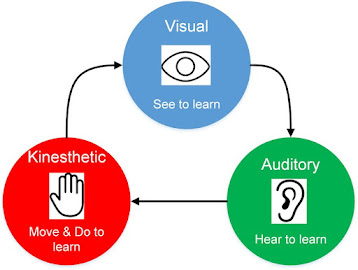Beginning in the 1920s, psychologists and child education experts like Fernald, Keller, Orton, Gillingham, Stillman, and Montessori created the initial VAK principles. At present VAK principles have become the preferred model within the accelerated learning community. The values and benefits of VAK learning have gone far beyond its original applications in accelerated learning. Everybody learns uniquely. To learn something, certain individuals must see it, some must hear it, and some must put it into practice (Gholami, & Bagheri, 2013). Depending on how they like to acquire and process information, learners can be classified as either visual, auditory, or kinesthetic learners. While auditory learners prefer to hear the material, kinesthetic learners learn best by doing. Visual learners can learn successfully when they see the materials. The three groups are recognized as VAK learning styles (Surjono, 2011).
Figure 01: VAK Learning Styles
Source:
(Injadat, 2022)
Figure 01 illustrates the three learning styles of VAK model.
Visual Learners
These
learners favor visual learning methods. As a result, they enjoy reading a lot,
which calls for attention and quiet time. Bulletin boards, videos, and movies
must provide visual stimulation for visual learners (Oxford, 1995 cited in
Gholami, & Bagheri, 2013). Individuals who prefer this style of learning
are those who learn through seeing things. They are inclined to see a concept as
a whole rather than individual part. Prefer a less formal setting to learn, a
traditional classroom environment may not be beneficial to them (Sreenidhi,
& Helena, 2017). As an example of visual learning, we can identify the use
of visual stimulating methods used by professional trainers in organizational
training programs like PowerPoint presentations, videos, pictures, and body
movements of the trainer.
Auditory learners
Auditory
learners enjoy the oral-aural learning channel. Thus, they want to engage in
discussions, conversations, and group work. These students typically require
only oral directions (Oxford, 1995 cited in Gholami, & Bagheri, 2013). An
auditory learner is able to follow verbal instructions readily and prefers to
hear information rather than read it. They have a tendency to adopt a
theoretical style of learning. Auditory learners are good at writing responses
to lectures they have heard and are also good at oral exams. Auditory learners
may be reluctant to make their own notes or conduct personal research. They may
prefer delivering presentations to a written report. Proponents claim that when
an auditory/verbal learner reads, it is almost impossible for the learner to
comprehend anything without sound in the background (Sreenidhi, & Helena,
2017). Auditory learning illustrates when organizations conduct brainstorming
sessions, discussions, and audio learning programs to educate and develop their
employees.
Kinesthetic Learners
These
individuals succeed in learning by feeling and acting out concepts. They enjoy
engaging in tactile experiences, such as touching, feeling, holding, doing, and
experiencing actual work (Surjono, 2011). Students who have predominantly
kinesthetic learning styles are thought to be natural discovery learners. Such
students need few verbal or written instructions and are confident in
participating in hands-on activities. Kinesthetic learners' short and long-term
memory is strengthened by their use of their own body's movements (Sreenidhi,
& Helena, 2017). We can identify the practical application of this concept
when organizations send their employees to off-site training facilities to
foster leadership skills and teamwork.
Referencing
Gholami, S. & Bagheri, M. S. (2013) Relationship between VAK learning styles and problem solving styles regarding gender and students' fields of study. Journal of Language Teaching and Research, 4(4), pp 700-6. (Online). Available at: http://www.academypublication.com/issues/past/jltr/vol04/04/08.pdf. Accessed on August 23, 2022.
Injadat, M. A. M. (2022) VAK learning styles model. ResearchGate.(Online). Available at: https://www.researchgate.net/figure/VAK-Learning-Styles-Model_fig1_326564924. Accessed on August 22, 2022.
Intel Corporation (2007) Designing effective projects: thinking skills frameworks learning styles. Intel Teach Program. (Online). Available at: https://acdowd-designs.com/sfsu_860_11/Styles.pdf. Accessed on August 23, 2022.
Surjono, H. D. (2011) The design of adaptive e-learning system based on student’s learning styles. International Journal of Computer Science and Information Technologies, 2 (5), pp 2350-53. (Online). Available at: http://staffnew.uny.ac.id/upload/131666733/penelitian/19+herman+dwi+surjono+The+Design+of+Adaptive+E-Learning+2011.pdf. Accessed on August 23, 2022.
Sreenidhi, S. K. & Helena, T. C. (2017) Styles of learning based on the research of Fernald, Keller, Orton, Gillingham, Tillman , Montessori and Neil D Fleming. International Journal for Innovative Research in Multidisciplinary Field, 3 (4), pp 17-25. (Online). Available at: https://www.researchgate.net/publication/317305325_Styles_of_Learning_VAK. Accessed on August 23, 2022.





No comments:
Post a Comment